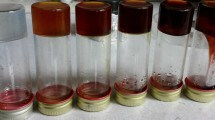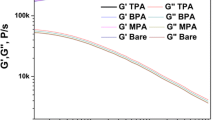Abstract
Poly-3-(9H-carbazol-9-yl)propylmethacrylate (pCMA) is synthesized as a polymer gel electrolyte and employed in the fabrication of dye-sensitized solar cells (DSSC). The pCMA was characterized by various analytical techniques to examine its structural and thermal properties. The photovoltaic and electrochemical effects of this electrolyte in DSSCs were investigated. From the results, it was found that DSSCs assembled with pCMA-PGE is an efficient electrolyte, which yields an open-circuit voltage 545 mV and current density 10 mA for a cell of area 0.25 cm2. pCMA-PGE device shows better performance (η = 2.2%), and it also performs as a good host polymer matrix for redox couple in the electrolyte.
Graphic abstract









Similar content being viewed by others
References
Chapin DM, Fuller CS, Pearson GL (1954) A new silicon p–n junction photocell for converting solar radiation into electrical power. J Appl Phys 25:676–677. https://doi.org/10.1063/1.1721711
Coyle DJ, Blaydes HA, Northey RS et al (2013) Life prediction for CIGS solar modules part 2. Prog Photovolt. https://doi.org/10.1002/pip.1172
Wu J, Lan Z, Lin J et al (2015) Electrolytes in dye-sensitized solar cells. Chem Rev 115:2136–2173. https://doi.org/10.1021/cr400675m
O’Regan B, Grätzel M (1991) A low-cost, high-efficiency solar cell based on dye-sensitized colloidal TiO2 films. Nature 353:737–740
Mathew S, Yella A, Gao P et al (2014) Dye-sensitized solar cells with 13% efficiency achieved through the molecular engineering of porphyrin sensitizers. Nat Chem 6:242–247. https://doi.org/10.1038/nchem.1861
Yao Z, Guo Y, Wang L et al (2019) Energy loss reduction as a strategy to improve the efficiency of dye sensitized solar cells. Sol RRL 1900253:1900253. https://doi.org/10.1002/solr.201900253
Benesperi I, Michaels H, Freitag M (2018) The researcher’s guide to solid-state dye-sensitized solar cells. J Mater Chem C 6:11903–11942. https://doi.org/10.1039/c8tc03542c
Carella A, Borbone F, Centore R (2018) Research progress on photosensitizers for DSSC. Front Chem 6:1–24. https://doi.org/10.3389/fchem.2018.00481
Hou W, Xiao Y, Han G, Lin JY (2019) The applications of polymers in solar cells: a review. Polymers (Basel) 11:1–46. https://doi.org/10.3390/polym11010143
Ileperuma OA (2013) Gel polymer electrolytes for dye sensitised solar cells: a review. Mater Technol 28:65–70. https://doi.org/10.1179/1753555712Y.0000000043
Mohan K, Bora A, Chandra B et al (2016) A highly stable and efficient quasi solid-state dye sensitized solar cell based on polymethyl methacrylate (PMMA)/ polyaniline Nanotube (PANI-NT) gel electrolyte. Electrochim Acta 222:1072–1078. https://doi.org/10.1016/j.electacta.2016.11.077
Murugadoss V, Arunachalam S, Elayappan V, Angaiah S (2018) Development of electrospun PAN/CoS nanocomposite membrane electrolyte for high-performance DSSC. Ionics (Kiel) 24:4071–4080. https://doi.org/10.1007/s11581-018-2540-4
Ma′alinia A, Asgari Moghaddam H, Nouri E, Mohammadi MR (2018) Long-term stability of dye-sensitized solar cells using a facile gel polymer electrolyte. New J Chem. 42:13256–13262
Önen T, Karakuş MÖ, Coşkun R, Çetin H (2019) Reaching stability at DSSCs with new type gel electrolytes. J Photochem Photobiol A Chem 385:112082. https://doi.org/10.1016/j.jphotochem.2019.112082
Chen T, Qiu L, Yang Z et al (2012) An integrated “energy wire” for both photoelectric conversion and energy storage. Angew Chem Int Ed 51:11977–11980. https://doi.org/10.1002/anie.201207023
Dubal DP, Chodankar NR, Kim DH, Gomez-Romero P (2018) Towards flexible solid-state supercapacitors for smart and wearable electronics. Chem Soc Rev 47:2065–2129. https://doi.org/10.1039/c7cs00505a
Cheng X, Pan J, Zhao Y et al (2018) Gel polymer electrolytes for electrochemical energy storage. Adv Energy Mater 8:1–16. https://doi.org/10.1002/aenm.201702184
Cao F, Oskam G (1995) A solid state, dye sensitized photoelectrochemical cell. J Phys Chem. 99:17071–17073
Chen CL, Chang TW, Teng H et al (2013) Highly efficient gel-state dye-sensitized solar cells prepared using poly(acrylonitrile-co-vinyl acetate) based polymer electrolytes. Phys Chem Chem Phys 15:3640–3645. https://doi.org/10.1039/c3cp50170a
Gnana kumar G, Balanay MP, Nirmala R, et al (2015) The photovoltaic performances of PVdF-HFP electrospun membranes employed quasi-solid-state dye sensitized solar cells. J Nanosci Nanotechnol 16:581–587. https://doi.org/10.1166/jnn.2016.10677
Xu T, Li J, Gong R et al (2018) Environmental effects on the ionic conductivity of poly(methyl methacrylate) (PMMA)-based quasi-solid-state electrolyte. Ionics (Kiel) 24:2621–2629. https://doi.org/10.1007/s11581-017-2397-y
Wu J, Lan Z, Lin J et al (2007) Influence of solvent on the poly (acrylic acid)-oligo-(ethylene glycol) polymer gel electrolyte and the performance of quasi-solid-state dye-sensitized solar cells. Electrochim Acta. 52(14):7128–7135. https://doi.org/10.1016/j.electacta.2007.05.055
Miettunen K, Vapaavuori J, Poskela A et al (2018) Recent progress in flexible dye solar cells. Wiley Interdiscip Rev Energy Environ 7:1–11. https://doi.org/10.1002/wene.302
Pavithra N, Asiri AM, Anandan S (2015) Fabrication of dye sensitized solar cell using gel polymer electrolytes consisting poly(ethylene oxide)-acetamide composite. J Power Sources 286:346–353. https://doi.org/10.1016/j.jpowsour.2015.03.160
Jovanovski V, Orel B, Ješe R et al (2005) Novel polysilsesquioxane – I−/I3− ionic electrolyte for dye-sensitized photoelectrochemical cells. J Phys Chem B 109:14387–14395. https://doi.org/10.1021/jp051270c
Anandan S, Pavithra N (2016) Silicotungustic acid incorporated gel polymer electrolyte as efficient redox mediator for dye sensitized solar cells. Synth Met 219:93–100. https://doi.org/10.1016/j.synthmet.2016.05.014
Wang Z, Wang L, Zhang Y et al (2017) Dye-sensitized solar cells based on cobalt-containing room temperature ionic liquid redox shuttles. RSC Adv 7:13689–13695. https://doi.org/10.1039/c6ra26402f
Dong RX, Shen SY, Chen HW et al (2013) A novel polymer gel electrolyte for highly efficient dye-sensitized solar cells. J Mater Chem A 1:8471–8478. https://doi.org/10.1039/C3TA11331K
Watanabe M, Ogata N (1987) In: MacCallum JR, Vincent CA (eds) Polymer electrolyte reviews-1. Elsevier, London. https://doi.org/10.1002/pi.4980200325
Appetecchi GB, Croce F, Ronci F, Scrosati B, Alessandrini F, Carewska M, Prosini PP (1999) Electrochemical characterization of a composite polymer electrolyte with improved lithium metal electrode interfacial properties. Ionics 5:59–63. https://doi.org/10.1007/BF02375904
Song JY, Wang YY, Wan CC (2000) Conductivity study of porous plasticized polymer electrolyte based on poly(vinylidene fluoride) a comparison with polypropylene separators. J Electrochem Soc 147(9):3219–3225. https://doi.org/10.1149/1.1393886
Xia K, Peng Z, Hu Z et al (2015) High efficiency quasi-solid state dye-sensitized solar cells based on a novel mixed-plasticizer modified polymer electrolyte. Electrochim Acta 153:28–32. https://doi.org/10.1016/j.electacta.2014.11.174
Wang Q, Moser JE, Grätzel M (2005) Electrochemical impedance spectroscopic analysis of dye-sensitized solar cells. J Phys Chem B 109:14945–14953. https://doi.org/10.1021/jp052768h
Kumar EN, Jose R, Archana PS et al (2012) High performance dye-sensitized solar cells with record open circuit voltage using tin oxide nanoflowers developed by electrospinning. Energy Environ Sci 5:5401–5407. https://doi.org/10.1039/c1ee02703d
Bard AJ, Faulkner LR (2001) Electrochemical methods: fundamentals and applications (2nd edn). Wiley-Interscience, New York
Acknowledgements
This research was financially supported by the Department of Science and Technology in India under the Solar Energy Research Initiative scheme (DST/TMD/SERI/S32). The author (Najat Marraiki) extends their appreciation to The Researchers Supporting Project Number (RSP-2020/201) King Saud University, Saudi Arabia.
Author information
Authors and Affiliations
Corresponding author
Ethics declarations
Conflict of interest
The authors declare that they have no conflict of interest.
Additional information
Publisher's Note
Springer Nature remains neutral with regard to jurisdictional claims in published maps and institutional affiliations.
Supplementary Information
Rights and permissions
About this article
Cite this article
Abdul Azeez, U.H., Gunasekaran, A., Sorrentino, A. et al. Synthesis and characterization of poly-3-(9H-carbazol-9-yl)propylmethacrylate as a gel electrolyte for dye-sensitized solar cell applications. Polym. Bull. 79, 921–934 (2022). https://doi.org/10.1007/s00289-021-03541-z
Received:
Revised:
Accepted:
Published:
Issue Date:
DOI: https://doi.org/10.1007/s00289-021-03541-z




